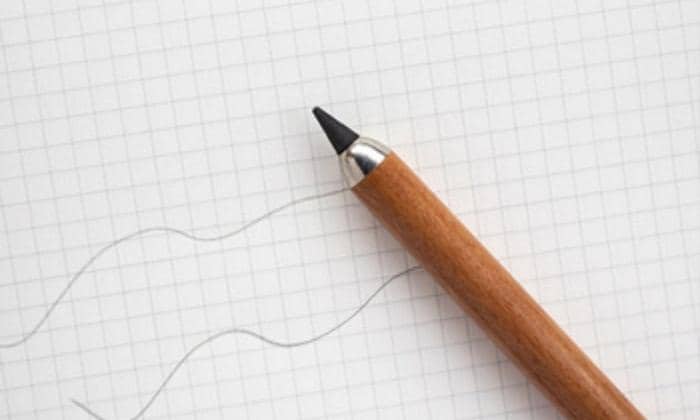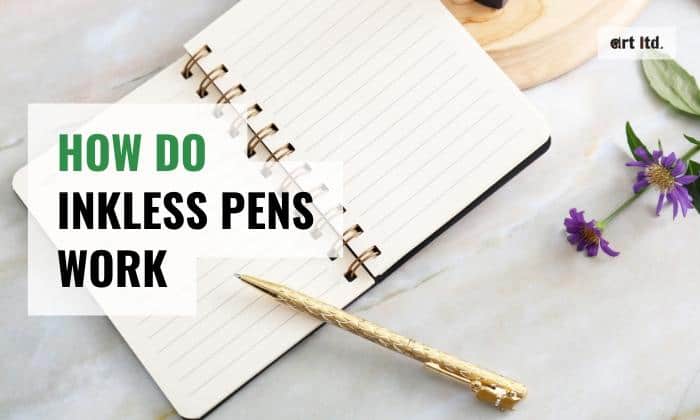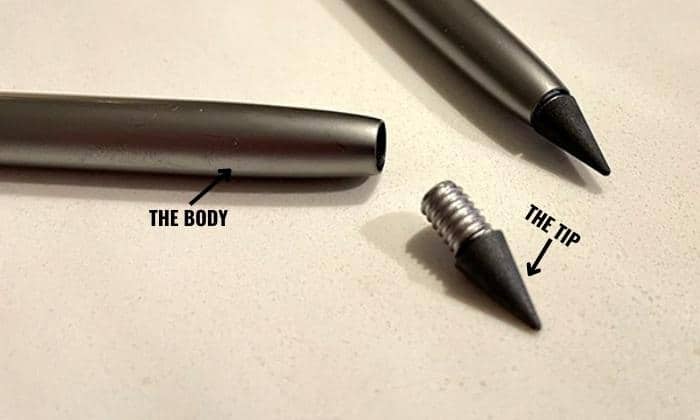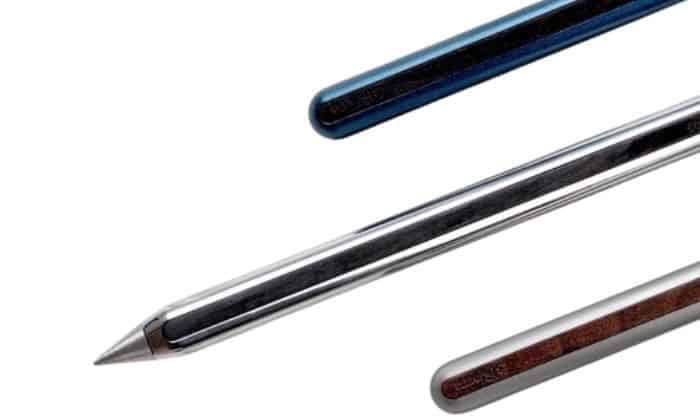When it comes to innovative writing tools, inkless pens are gaining popularity for their longevity and eco-friendly design. These never-ending pens represent a significant shift from conventional pen design.
Without ink cartridges, how do inkless pens work? Essentially, inkless pens use a special metal alloy tip that leaves a mark on most types of paper due to a chemical reaction between the alloy and the paper.
This article will delve deeper into the intricacies of this technology, exploring the components of these pens and the science behind their function. Let’s keep reading!
Table of Contents
Components of an Inkless Pen
An inkless pen typically consists of two primary components:
- The Body: The body of an inkless metal pen is usually constructed from durable materials like anodized aluminum, stainless steel, or brass to ensure it withstands daily wear and tear. The design can be sleek and minimalistic, or it may mimic the form of a traditional pen.
- The Tip: Instead of a conventional ink-filled reservoir, these pens feature a special alloyed metal tip. This tip is made from materials like lead, which react with the paper to leave visible marks when writing. The marks are often gray, resembling pencils but are permanent and smudge-proof.
Inkless Pen Technology
Inkless pen technology is a fascinating innovation that harnesses the principles of chemistry to revolutionize the way we write. Instead of using a reservoir of ink, this forever pen employs a special metallic alloy tip that makes visible marks on paper through a process known as oxidation.
1. Oxidation
The principle of oxidation is the foundation of inkless pen technology. Oxidation is a process where a substance loses electrons.
In the context of an infinite pen, when the metallic tip comes in contact with the paper, it undergoes minor oxidation due to friction.
The paper’s surface pulls minute particles from the pen’s metal tip, which then oxidize and leave a visible mark. Essentially, the paper’s surface becomes a canvas for these oxidized particles.
The lines produced by an inkless pen resemble pencil markings but are permanent and smudge-proof. Moreover, they are waterproof, further increasing their permanence.
2. The Special Metal Alloy Tip
The tip of an inkless pen is not made of ordinary metal but a special alloy that reacts with the paper to produce visible markings.
This tip often contains trace amounts of lead, which facilitates the oxidation process.
So, are inkless pens safe? Although the quantities of lead in inkless pens are so small, it’s crucial to keep them away from young children who might put the pen in their mouths. With normal use, they pose no health risks.
What to Notice Before Purchasing Inkless Pens?

While inkless pens are innovative and practical, they do have certain aspects that could be seen as downsides.
Firstly, the lines produced by inkless pens aren’t as dark as those produced by traditional ink pens. The marks resemble pencil lines, often appearing gray on the paper.
If you require clear, bold lines for your writing or drawing, an inkless pen might not meet your expectations.
In addition, the nibs seem durable in the act of writing, they can be brittle and prone to shattering or cracking if dropped.
A fall from your desk where the nib hits the floor first could potentially damage the pen. Therefore, careful storage is crucial when using inkless pens.
FAQs
Inkless Pens vs. Traditional Pens
Here is a comparison between inkless pens and traditional pens:
Inkless Pens
- No ink refills are required, offering potentially lifelong use.
- Leave permanent, smudge-proof marks.
- Operate in various conditions, including underwater and zero gravity.
- Only leave marks in one color, usually gray similar to a pencil.
Traditional Pens
- Require regular ink refills.
- Have a variety of color and style options.
- May smudge or leak, potentially messing up your writing.
- Limited to use in normal conditions. They also may not work underwater.
Benefits Of Using Inkless Pens
Are you looking for a pen that never runs out of ink? An inkless Pen will satisfy you, and here are the reasons!
- Longevity: The inkless pen is no ink pen that lasts forever. You never have to worry about your pen running out of ink at a crucial moment.
- Eco-friendliness: Inkless pens contribute to environmental sustainability. They remove the need for plastic ink cartridges, thus reducing waste.
- Versatility: Inkless pens can write in numerous conditions, including underwater, in zero gravity, and in extreme temperatures. This versatility makes them popular among outdoor enthusiasts, space travelers, and more.
- No smudging or leaking: The absence of ink eliminates the risk of smudging or leaking. This feature makes these pens a preferred choice for left-handed writers.
Different Types Of Inkless Pens
Inkless pens come in several types, including brands like Forever, Pininfarina (Napkin), and AUAUY.
Forever, known for high-quality products, offers the stylish Cuban Everlasting Pencil Tobacco and the sleek Primina Everlasting Pencil.
Meanwhile, Pininfarina brings to the market the versatile GrafeeX Pencil and the aeronautically-inspired Segno Aero Everlasting Pencil under the Napkin brand.
AUAUY adds to the diversity in this space, producing reliable inkless pens with a more budget-friendly approach.
Each brand offers a wide range of prices that fit every budget.
Conclusion
Hopefully, this article helps you understand how do inkless pens work. Inkless metal pens use the principle of oxidation to leave a mark on paper through a special metal alloy tip instead of ink.
They offer practical benefits, including lifetime usability, environmental sustainability, and the ability to write under various conditions.
Despite certain downsides, such as less bold lines and the fragility of the tip, their innovative technology and ecological benefits make them an appealing alternative to traditional ink pens.

Art has always been a part of my life; it influences my upbringing and later my career choice. For me, it is always a part of my parenting technique. So for whichever purpose that you come to art, you can start here with us.



